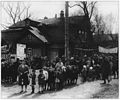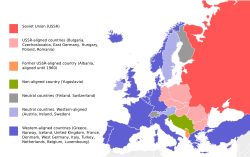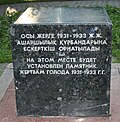The Soviet Union introduced collectivization (Russian: Коллективизация) of its agricultural sector between 1928 and 1940. It began during and was part...
66 KB (8,081 words) - 14:17, 5 June 2025
Despite the vast death toll in the early stages, Stalin chose to continue the Five Year Plan and collectivization. By 1934, the Soviet Union had established...
142 KB (17,391 words) - 11:23, 24 July 2025
western historians point to collectivization as a cause of the large-scale famine in the Soviet Union between 1932 and 1933 in which 3.3 to 7.5 million died...
43 KB (5,089 words) - 06:51, 6 June 2025
Dekulakization (category Human rights abuses in the Soviet Union)
and of building socialism in the countryside. This policy, carried out simultaneously with collectivization in the Soviet Union, effectively brought all...
34 KB (4,395 words) - 04:34, 17 July 2025
Religion in the Union of Soviet Socialist Republics (USSR) was dominated by the fact that it became the first state to have as one objective of its official...
51 KB (6,413 words) - 01:10, 22 July 2025
Turmoil of Soviet Russia 100 Years Ago". 5 September 2018. Livi-Bacci, Massimo (1993). "On the Human Costs of Collectivization in the Soviet Union". Population...
60 KB (5,935 words) - 02:53, 14 June 2025
Agriculture in the Soviet Union was mostly collectivized, with some limited cultivation of private plots. It is often viewed as one of the more inefficient...
38 KB (4,752 words) - 21:03, 25 May 2025
The economy of the Soviet Union was based on state ownership of the means of production, collective farming, and industrial manufacturing. An administrative-command...
75 KB (8,217 words) - 19:50, 12 July 2025
Revolution" with the introduction of state socialism and central planning. In the early-1930s, he initiated collectivization of Soviet agriculture, by...
40 KB (4,994 words) - 08:07, 7 July 2025
Human rights in the Soviet Union were severely limited. The Soviet Union was a totalitarian state from 1927 until 1953 and a one-party state until 1990...
36 KB (4,106 words) - 16:35, 4 July 2025
repression.: 478–481 In 1928, the Soviet Union underwent a goods famine known as the Soviet grain crisis; this led to the forced collectivization of agriculture...
24 KB (2,636 words) - 06:11, 23 July 2025
1930s (redirect from Wars in the 1930s)
factors to the famine include: the forced collectivization in the Soviet Union of agriculture as a part of the First Five-Year Plan, forced grain procurement...
97 KB (10,268 words) - 08:55, 25 July 2025
Holodomor (redirect from Famine in Ukraine)
characteristics, one with zero collectivization rate and another with a 100 percent collectivization rate, the more collectivized region's 1933 mortality rate...
280 KB (29,936 words) - 19:42, 27 July 2025
From 1930 to 1952, the government of the Soviet Union, on the orders of Soviet leader Joseph Stalin and under the direction of the NKVD official Lavrentiy...
97 KB (8,664 words) - 19:39, 20 July 2025
1929 Buryat Revolt (category Rebellions in the Soviet Union)
and Soviet ethnic policies. In 1928, the Soviet Union under the leadership of Joseph Stalin implemented a forced policy of collectivization across the Soviet...
5 KB (413 words) - 20:14, 31 March 2025
After the Munich Agreement, the Soviet Union pursued a rapprochement with Nazi Germany. On 23 August 1939, the Soviet Union signed a non-aggression pact...
130 KB (16,410 words) - 21:25, 20 July 2025
editorial control of the party's monthly theoretical magazine, Bolshevik. Collectivization in the Soviet Union Hyperinflation in early Soviet Russia Prodrazvyorstka...
19 KB (2,399 words) - 23:19, 8 November 2024
characteristics, one with zero collectivization rate and another with a 100 percent collectivization rate, the more collectivized region’s 1933 mortality rate...
151 KB (18,599 words) - 20:48, 19 June 2025
in the Soviet Union was a process of accelerated building-up of the industrial potential of the Soviet Union to reduce the economy's lag behind the developed...
68 KB (8,467 words) - 19:01, 24 July 2025
Propaganda in the Soviet Union was the practice of state-directed communication aimed at promoting class conflict, proletarian internationalism, the goals...
85 KB (10,956 words) - 07:55, 1 July 2025
The history of the Soviet Union (USSR) (1922–91) began with the ideals of the Russian Bolshevik Revolution and ended in dissolution amidst economic collapse...
93 KB (10,059 words) - 10:25, 20 July 2025
Eastern Bloc (redirect from Economies of the Soviet Bloc)
collectivization through massive state farms and agricultural producers' cooperatives (APCs). Instead, collectivization proceeded more slowly and in stages...
224 KB (22,728 words) - 02:28, 28 July 2025
The Polish minority in the Soviet Union are Polish diaspora who used to reside near or within the borders of the Soviet Union before its dissolution....
16 KB (2,010 words) - 18:19, 24 November 2024
Collective farming (redirect from Collectivization)
by which farmland is aggregated is called collectivization. In some countries (including the Soviet Union, the Eastern Bloc countries, China and Vietnam)...
53 KB (6,234 words) - 07:41, 25 July 2025
plans in the Soviet Union, beginning in the late 1920s. The Soviet state planning committee Gosplan developed these plans based on the theory of the productive...
34 KB (3,958 words) - 12:34, 15 July 2025
Socialist state (communism) (category Dictatorship of the proletariat)
party) to lead the state. The theoretical exception to this rule was the Soviet Union: from 1961 onwards the Communist Party of the Soviet Union (CPSU) argued...
17 KB (2,161 words) - 03:40, 28 July 2025
his enemies while transforming Soviet society with central planning, in particular through the forced collectivization of agriculture and rapid development...
103 KB (12,923 words) - 02:52, 14 June 2025
alive. The impact of collectivization and the Second World War was to reduce the 1989 population of the Soviet Union by 27%. Kokaisl, Petr. "Soviet collectivisation...
31 KB (3,436 words) - 22:40, 9 July 2025
Kazakh famine of 1930–1933 (redirect from Famine in Kazakhstan of 1932-1933)
after the famine. The famine is seen by some scholars as belonging to the wider history of forced collectivization in the Soviet Union and part of the Soviet...
64 KB (7,482 words) - 05:46, 12 July 2025
the world denounced the Khrushchev line as revisionist. Mao Zedong first denounced the Soviet Union as revisionist at a meeting in January 1962. In early...
6 KB (552 words) - 12:00, 29 June 2025



















